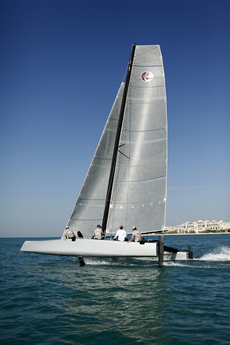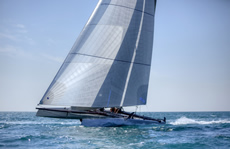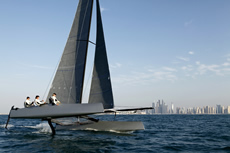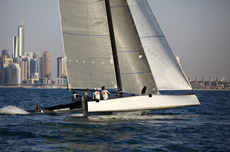
New foiling cat racing circuit
Multihulls are back in the Olympics, the America’s Cup is being raced in them and the Extreme Sailing Series continues to go from strength to strength. At present the MOD class may be having a few teething problems, but with the G-Class maxis (both fully crewed and solo), the MOD70s, the modified ORMA 60s and the Multi50s, there are probably more multihulls being raced offshore than ever before. Today, for those of us who have been fans of this genre of sailing for several decades, the unimaginable has happened: multihulls are teetering on the brink of being mainstream and respectable.
Amid this a new inshore multihull circuit is taking shape. The Great Cup will be sailed in state of the art 32ft foiling catamarans, known as GC32s. Owners and sailors taking part, effectively get a piece of AC34-style airborne catamaran action for a fraction of the price, without any hazardous wrestling with wings during launch and retrieval.
Comparisons will of course be made with the Extreme Sailing Series. The significant difference is that the Great Cup is geared up to appeal more to private owners and will be less orientated towards ultra-short course ‘stadium sailing’ race formats. The circuit will also be less globe trotting and will simply follow the more classic model of having local fleets, the cream of which come together occasionally for major events such as World Championships.
Origins
The Great Cup is the brainchild of Amsterdam-based French businessman Laurent Lenne and well known Aussie cat sailor Andrew Macpherson. The two originally met when Macpherson coached Lenne on F18s, before Lenne began to contemplate graduating up to a bigger boat. They came within a hair of putting in an offer on the Oracle Extreme 40, but ultimately steered away from this.
“There is too much going on where the private owner doesn’t get enough return on their investment,” as Lenne puts it, specifically referring to the Extreme Sailing Series’ complex logistics, the constant travel and the lack of access to one’s boat during this period.
As a result Macpherson and Lenne began contemplating a new circuit aimed primarily at other like-minded private owners wanting to race high performance catamarans but without the commercial jamboree. “What we are trying to do is get a different balance between owners/racers and sponsors,” Lenne explains. “To me the Extreme 40 is very much about the sponsored part, whereas if you look at the RC44s, that is fully geared towards the owners and they don’t give a damn about the sponsored side – they go where they want and that’s it.”
Lenne wants the Great Cup to navigate a route between these two poles, more akin to the Melges 32 or Farr 40 circuits, where Audi and Rolex respectively step in to back some of their racing, bringing added marketing clout to help boost the profile of their circuit internationally, but with the class strong enough to continue even if there is no title sponsor.
To get the Great Cup going, Macpherson initially researched the rest of the 30 something foot racing multihull market, looking for suitable candidates. This included the Swiss lake boats – the D35 and M2 - as well as the Marstrom M-32 and the AC team’s training boat favourite, the Hakes Marine-built Morrelli and Melvin-designed SL33. However as potential fleet racing boats Macpherson found flaws in them all – the lake racers not faring well on the open water, the M32 and SL33 both having racks and the former being unarigged.
As Laurent Lenne explains: “We knew the boat was going to be very fast and the possibility of a crash quite high, so we didn’t want racks.” Hence why the AC45 also don’t have racks, he observes.
There was the feeling that it was time for a contemporary catamaran design at this size, purpose-built to go foiling. As Macpherson says: “Multihull sailing is heading more mainstream and you need a tool for that.” Hence at the beginning of 2012 Lenne agreed to press the button on the GC32 and a circuit to go with it, the circuit being a vital part Macpherson reasoning that it is a bit like buying a Porsche GT3RS but having no race track to take it around. “We want to offer owners an excuse to buy the boat – ‘if you buy the boat then I’ll organise good quality racing’.”
Nuts and bolts
In conceiving the GC32 they enlisted the design expertise of Martin Fischer, whom Macpherson had worked with on the Phantom F18, in which Olivier Backes and Matthieu Vandame won last year’s Worlds in Los Angeles. Fischer previously designed the groundbreaking Capricorn F18 which had so impressed Franck Cammas that he enlisted Fischer onto the design teams of both his Groupama 2 and 3 trimarans as well as his Volvo Ocean Race winning VO70.
The brief for the new GC32 was for an inshore boat that could be raced in coastal venues (ie in waves) in up to 25 knots of wind. As it will typically be an owner-driver boat, the GC32 had to be well behaved without for example overly stressful bearaways – hence the GC32 has much improved longitudinal stability. “If you scale an AC45 down to 33ft, which is what our boat is, we ended up comparatively with 1% more drag, but 25% more longitudinal stability,” says Macpherson. And this is before the lifting foils are added to the equation. “Then obviously there was the standard performance request: make it the fastest boat ever!”
In general concept the GC32 has all the familiar parts you’d expect of a cat of this type – two hulls with ‘Dreadnought’ bows, two crossbeams, trampoline, bowsprit, rotating wingmast, flat top main – check. There is an extra spine, Alinghi 5/AC45 stylee, between the mast step and aft beam to help with the fore and aft rig loads. The boat is a little squarer than an Extreme 40, 10m long with a 6m beam (ie 60%), compared to the 40’s 7m beam(ie 57.5%). However the most significant area of development, as is the case with the AC72, has of course been the foils. As a test bed for developing these they used a Phantom F18 (now in Franck Cammas’ possession), and the GC32 has ended up having S-profile daggerboards and L-profile rudders.
“We had a pretty clear mandate from the outset that we wanted a boat that would exhibit reliable performance across a wide range,” states Macpherson. But significantly compared to the AC45s and 72s they didn’t want the hassle of having to raise and lower boards every time they tack. On the AC cats Macpherson observes that one of the reasons they are obliged to do this is to prevent teams from using the weather foil to increase righting moment by generating negative lift. However without this constraint, with the GC32, where, like the Extreme 40s (which features symmetric boards) they sail with the boards constantly down, they can and do.
What does change tack to tack is the pitch of the foils. On the GC32 the foils can be pivoted fore and aft around the bottom bearing while the top bearing is oversized longitudinally. This allows up to 3° of pitch to be induced in each foil. Macpherson explains: “When you pull it back to 3°, the boat will fly way earlier than you think it should, because you are massively increasing the lift. And then as soon as it is flying, you push the board forwards and it pulls the hull back down.” Obviously how much vertical lift the foil is set to generate depends greatly on the speed of the boat, but in conditions where it needs trimming this job typically falls to the bowman. The pitch on each foil can be controlled from each cockpit via a 2:1 purchase.
S-Foils
We’ve seen them trialling on Alinghi 5 and (we think) on all the AC72s - but how do they actually work? The concept is that thanks to their S-shape, the amount of vertical lift they generate changes according to how much the boards are raised or lowered. This, Macpherson says, represents a significant improvement over C-shaped foils, as used currently in the A-Class and on boats like the Nacra 17 and 20.
“What the C-foil does is in fact the complete opposite to what you want a foil to do - the windier it gets or going downwind, you want to raise the daggerboard a bit, but as soon as you raise it you reduce the lifting surface which is when you want it the most. The S-foil reverses that trend by having the little bend in it – when you raise the board a little bit, it increases the lift, so you get rid of surface area while increasing lift.”
On the GC32, with the boards down, the dihedral (ie the angle between the board exiting the hull and the foil tip) is just 10°. But hoist the foil by only around 40cm and thanks to the curvature of the board the dihedral increases to 40°, creating a much larger lifting surface.
“What we have found is that basically when it is light you leave the boards down, and when it is windy you can sail upwind with the boards in their downwind position - you have enough pace to deal with the leeway,” says Macpherson.
An added advantage of sailing with four foils in the water (whereas AC72s for example are sailing on only two, flying a hull) is that it makes for a more comfortable, predictable ride. “We made our rudders too long, so that if you are sailing in big waves, the boat is quite high, semi-foiling,” says Macpherson. “I don’t think you need the boat to be sailing 5ft out of the water, you just want it to transition smoothly from being a hulled boat to being a foil boat.”
But doesn’t having four foils constantly in the water create huge amounts of drag? “With the S foil, when you put it all the way down, it is only a 10° dihedral, so a very minute difference in drag compared to a straight foil," says Macpherson. "That is why when you are going upwind in the lighter stuff and you want maximum grip, you are basically performing as per normal. So you get the best of both worlds.”
Unlike the T-foils found on the rudders of AC72s, Moths, International 14s, etc the GC32’s rudders are fitted with L-foils. The bottom of the ‘L’ is angled downwards so that, like the S-foil daggerboard in their maximum lift mode, they self-regulate, establishing a ride height according to their speed: the faster the boat goes, the more of the foil lifts out of the water, in turn reducing the lifting surface, dropping it down again. However the pitch of the rudder foils can also be adjusted – they are mounted on a false transom plate which is hinged, allowing a range of movement up to 1.5° in 0.2° increments. This is changed via a fast pin on the transom, and so is typically set for the day or only changed between races.
Big pressure
As one might imagine, the loads in the foils are significant. To handle the engineering they have brought in Brett Ellis who was part of Alinghi’s design team when they worked on their big cat (on which they also used S-foils). However their F18 test platform also provided a lot of data.
“It was quite stunning the loads just on the F18,” recalls Macpherson. “If you have a little bit of leeway and because of the curvature in the board – the windward board always wants to go down through the case, to the extent that on the F18 you need two hands to stop it even if you’ve only got two knots of boat speed on. On the 32 that windward daggerbaord creates about 80kg of extra righting moment, so it is like having another big guy on the rail.” Imagine scaling that up to an AC72 (if it were allowed...)
The foils are all built by Heol Composites in France. Otherwise construction of the GC32 at Premier Composites in Dubai is in carbon with a foam core and according to MacPherson the platform has been engineered to be mega-stiff.
Foiling = safety
While it may look precarious, there is a developing theory that foiling might make catamarans safer. Certainly it makes them pitch less, in turn improving air flow over the rig.
“I have yet to get the tip of the bow underwater,” says Macpherson. And they have been trying: “I went out with Bastian (Tentij) who sails with Mischa [Heemskerk] on the F18 and Mikke Lundt, who has done a couple of Volvo Ocean Races and we were trying stupid stuff - pulling bear aways in 15 knots with two guys sitting on the bow and not letting the main sheet go...and nothing happened. It just turned! I’m sure if you try it in 25 knots and you’re having a tea party on the front beam, then maybe that wouldn’t be the case. But the horizontal section of the ‘L’ on the rudder is designed for a maximum load of 380kg and you have got two of them: It is like stacking everyone on the transom! I think the only way this is going to turn over is sideways. It is certainly going to be hard work putting it in frontwards.”
So in theory the GC32 should be safer than older generation/non-foil assisted cats and Macpherson believes this will be an attractive feature for private owners. “The behaviour of the boat had to be exceptional otherwise we were going to scare people. The guys with the money don’t want to hurt themselves at the weekend because they have to go to work next week.”
Laurent Lenne agrees: “To me as an owner the first time you step on the boat it is like ‘this is impressive’. But as soon as you sail it, you feel safe very quickly. You can bear away ten times better than you can in an Extreme 40, for sure.”
There is always the prospect of a repeat of Alinghi 5’s dramatic reverse near-capsize when she was using her S-foils during pre-AC33 training in Italy, but Macpherson says the L-foils on the rudders would prevent this from happening on the GC32.
“For me it has changed the way I think about sailing a catamaran, because you don’t have those issues. On the smaller cats it is okay because you can move your body weight around a lot to deal with it, but progressing to having horizontal control on the rudders is logical - I don’t see too many airplanes going around without a tail plane.”
With the GC32 it is still early days in terms of her foiling. They have been working the first boat up in Dubai, near where she is built by Premier Composites, who also build the Farr 400 and Carkeek HPR 40 and 45 monohulls. At present she has been fully foiling in 15 knots of wind at which point she was hitting just over 27 knots, says Macpherson: “Once she gets up, she boogies. Normally we’d go downwind and the boat is doing 22-3 knots in 10 knots of breeze and all of a sudden you break through that with another bit of breeze and then you are hitting 27 odd. I can’t wait to get it into a proper 18 knots.”
Macpherson is expecting a top speed exceeding 30 knots (not bad for a 32 footer). Upwind they are already managing 15 knots in less than 15 knots of wind. But most impressive to him is how they have managed to sit on 22 knots two sail reaching in just 8-9 knots of breeze. For stronger conditions (ie above 18 knots) they are able to put a reef into the main.
Aloft
Above decks, the GC32 is equipped with a Southern Spars tubes and PBO standing rigging from EasyRigging, although the rigging for the bowsprit/centre spine dolphin striker is in carbon EC6.
With a 320x140 section, the mast is a two piece. The spars use a conventional carbon fibre laminate rather than Southern’s TPT. However 3Di is being used for the North sails fitted to date (although the rule for the GC32 will allow teams to use their own sailmakers).
The sail plan on the GC32 was designed by Gautier Sergent, who again has worked closely with Groupama and was their VO70 sail designer. Sail measurement will be simple, just using the battens, says Macpherson: “There is a location of the inboard end down the luff, and then we have a batten length measurement – and that’s it!”
In terms of sail size, the main is 60sqm compared to the Extreme 40s’ 75, while up front the areas are more similar: thanks to the hounds being higher and there being a larger J measurement on the 32, the jib is 24sqm compared to the 40’s 25 and the kite is 90 to the 40’s 110. The mast is 16.6m long, only 1.2m shorter than the 40’s.
Not having strict one design sails is a little worrying as the implication is that a big team could come in and spend zillions on development. However Macpherson points out that the GC32 will have a sail button system to prevent this. Initial plans are to limit sail replacement to one full set per season and then, depending on the number of races per year, they might add another jib to this. Certainly the 3Di sails they been using seem to be lasting the course. “We have a Cuben kite and it just looks brand new and we’ve beaten the crap out of it,” Macpherson reports.
$$$$$
The price of the GC32 is 185,000 Euros, ex sails, electronics, delivery and VAT (if coming to Europe). So this is substantially more than a Melges 32, which costs 120,000 Euros, but the GC32 is a vastly more complex state of the art boat with twice the number of hulls and foils. However the cost with such boats is less in the initial capital costs and more in the campaigning and annual running costs. In this respect the GC32 will be sailed by only four crew (ie half that of a Melges 32) and only has three sails, so running costs should be considerably less. In terms of transportation two GC32s can be fitted into a 40ft container.
Weighing in the order of 750kg, launching the GC32 is obviously easier by crane, but in Dubai they have been launching their GC32 on its trailer, reversing it into the water behind a car and launched it from there. The S-foils fit in from the top, the rudders from below.
Circuit
At present Laurent Lenne is bank rolling the project with the business model deriving profit from boat sales and regatta venue agreements.
To date three boats have been built, including one to Swiss Olympic Star sailor Flavio Marazzi and they are hoping for two more to be launched imminently. One can imagine that going forwards if the America’s Cup stays in foiling catamarans then the GC32 could become the boat of choice for AC teams looking to carry out R&D as the 32 is already fitted with the necessary bearing arrangement that accepts all manner of different foil designs. This also allows the GC32 itself to be turboed in the future as more innovations will inevitably emerge in lifting foil design, although Macpherson states: “It would have to be a really amazing change in all conditions to make it better than what we have now.”
While fitting a wing to the GC32 hasn’t been contemplated purely for reasons of logistics, the boat has also been designed with a mast step that could accept a wing if required.
In terms of potential owners, Lenne and MacPherson have been talking to everyone from owners of superyachts and RC44s to younger teams of budding pro sailors looking to raise money commercially.
The Great Cup itself debuts in Europe with the first batch of GC32s set to race on Lake Trausee, Austria over 9-12 May, the same venue where the RC44s have raced in previous years. They will then move on to Lake Geneva where they will compete in the Geneve-Rolle-Geneve and the Bol d’Or Mirabaud. GC32s are also expected to compete in regattas around Europe this summer, including, possibly, Aberdeen Asset Management Cowes Week. With the boat being built in Dubai, there is also a strong case for starting up a local circuit in the Gulf region allowing European sailors to compete over the winter months.
The ultimate aim is to get local fleets developing in Europe, the US and Australasia and getting them all to meet up annually at World Championships.
“My dream is sailing off Porto Cervo in these things with a fleet of 25-30 boats on a one mile windward-leeward. It would be just awesome...” Macpherson concludes.
More photos from Christophe Launay/www.sealaunay.com
 |
 |
 |
 |
 |
 |
 |
 |
 |
 |
 |
 |
 |
 |
 |
 |
 |
 |
 |
 |
 |
 |
 |
 |
 |
 |
 |
 |
 |
 |
 |
 |
 |
 |
 |
 |
 |
 |
















Latest Comments
Add a comment - Members log in